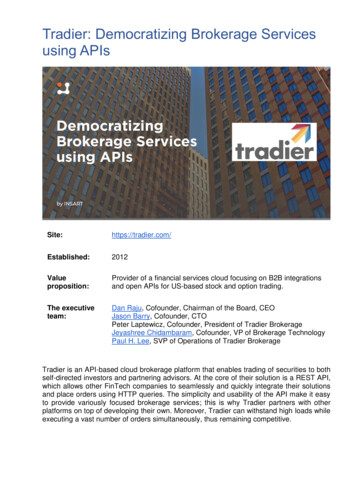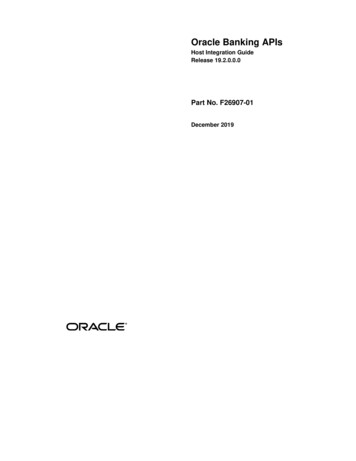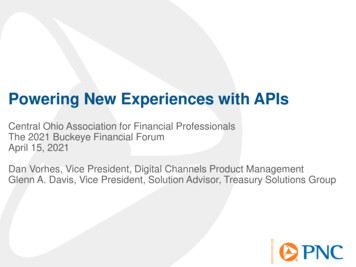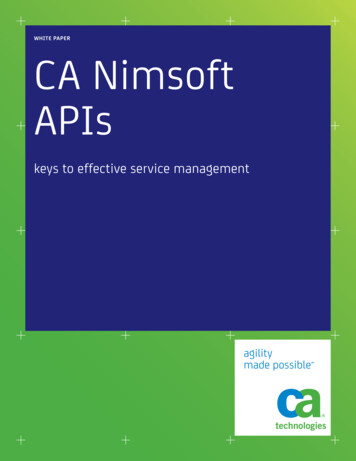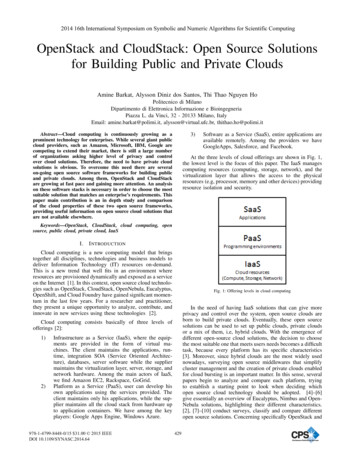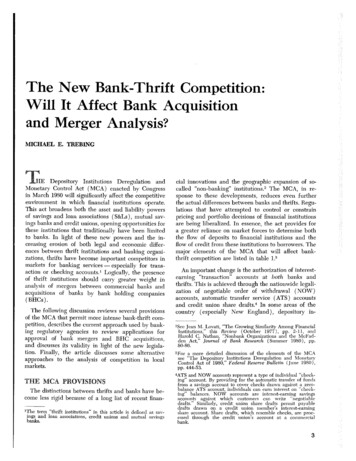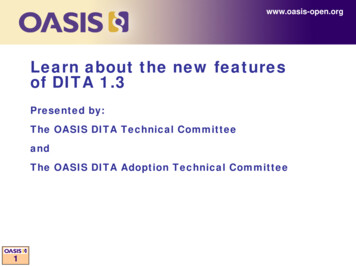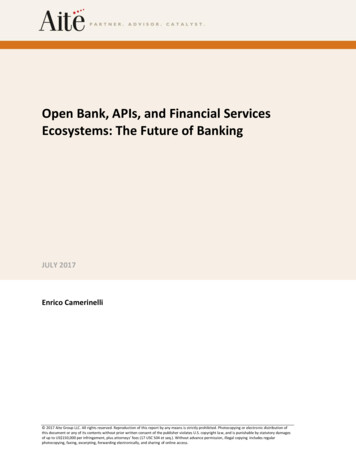
Transcription
Open Bank, APIs, and Financial ServicesEcosystems: The Future of BankingJULY 2017Enrico Camerinelli 2017 Aite Group LLC. All rights reserved. Reproduction of this report by any means is strictly prohibited. Photocopying or electronic distribution ofthis document or any of its contents without prior written consent of the publisher violates U.S. copyright law, and is punishable by statutory damagesof up to US 150,000 per infringement, plus attorneys’ fees (17 USC 504 et seq.). Without advance permission, illegal copying includes regularphotocopying, faxing, excerpting, forwarding electronically, and sharing of online access.
Open Bank, APIs, and Financial Services Ecosystems: The Future of BankingJULY 2017TABLE OF CONTENTSIMPACT POINTS . 3INTRODUCTION . 4METHODOLOGY . 4THE MARKET . 6THE NEED FOR APIS . 8THE RISE OF THE NEOBANKS . 10BANK STRATEGIES FOR DEPLOYING APIS. 11MONETIZING OPEN BANKING . 14THE CHALLENGES ASSOCIATED WITH OPEN API BANKING . 18EA/IT PORTFOLIO MANAGEMENT . 20CONCLUSION. 26RELATED AITE GROUP RESEARCH. 27ABOUT AITE GROUP . 28AUTHOR INFORMATION. 28CONTACT . 28LIST OF FIGURESFIGURE 1: CLIENT NEEDS ARE IMPORTANT REASONS FOR APIS . 9FIGURE 2: GOVERNMENTAL DIRECTIVES’ OR REGULATIONS’ INFLUENCE ON BANKS’ API STRATEGIES . 10FIGURE 3: API INITIATIVES AT BANKS . 11FIGURE 4: BANK EXPECTATIONS REGARDING API DEPLOYMENT AND BUSINESS PARADIGMS . 13FIGURE 5: TOP BUSINESS PRIORITIES FOR API DEVELOPMENT—PAYMENTS AND CASH MANAGEMENT. 14FIGURE 6: OPEN-BANKING MODELS. 15FIGURE 7: MOST LIKELY REVENUE MODEL BANKS WILL IMPLEMENT . 16FIGURE 8: PRODUCT MANAGEMENT AREAS INVOLVED IN API PROJECTS. 21FIGURE 9: TOP BUSINESS PRIORITIES FOR API DEVELOPMENT: PAYMENTS AND CASH MANAGEMENT . 22FIGURE 10: BANKS’ PRIORITIES FOR TRANSACTION BANKING APIS . 23LIST OF TABLESTABLE A: THE MARKET . 6TABLE B: API BUSINESS MODELS . 12 2017 Aite Group LLC. All rights reserved. Reproduction of this report by any means is strictly prohibited.101 Arch Street, Suite 501, Boston, MA 02110 Tel 1.617.338.6050 Fax 1.617.338.6078 info@aitegroup.com www.aitegroup.com2
Open Bank, APIs, and Financial Services Ecosystems: The Future of BankingJULY 2017IMPACT POINTS The market is demanding that banks open their architectures. Ninety-five percent ofrepresentatives from European, Asia-Pacific, and North American banks report theyare creating, documenting, and distributing application programming interfaces(APIs) for integrating internal systems, while 81% share APIs with trusted partners. Fifty-two percent of responding banks plan to start supporting an open-bankingplatform that allows developers access to the bank via published APIs in the nexttwo years. Challenges associated with open API banking relate to integration issues with wherethe data is across the bank and where it will be shared, as well as automation issues.Banks also face the risk of being disintermediated from their customers. Open banking requires an upfront enterprise application (EA) and informationtechnology (IT) portfolio management planning exercise to document where thedata is, how it will be shared, and with whom it will be shared. Globally, banks today are concentrated on payment-centric API strategies. In thenext two years, banks will move to a wider corporate transaction banking-based APIplan, offering access to transaction banking processes: cash management, liquiditymanagement, and treasury. Banks need to assess their role in the API ecosystem and champion the developmentof new products and services, or they will be disintermediated from their customers,at the risk of being relegated as back-end hidden utilities in much the same way thatclearing and custody is the back-end hidden utility of securities trading. 2017 Aite Group LLC. All rights reserved. Reproduction of this report by any means is strictly prohibited.101 Arch Street, Suite 501, Boston, MA 02110 Tel 1.617.338.6050 Fax 1.617.338.6078 info@aitegroup.com www.aitegroup.com3
Open Bank, APIs, and Financial Services Ecosystems: The Future of BankingJULY 2017INTRODUCTIONAn API is like a user interface but with different users in mind, i.e., computer applications andtheir programmers. By publishing an API, a provider of a service (e.g., a bank) makes it easier fordevelopers to build applications that use that service. Banks are beginning to expose their datafor use by third parties, in particular fintech companies, through APIs. Banks can not only maketheir own product data available but can also allow their customers to share their bank data withthird-party providers (TPPs), thus paving the way for “open banking.”An API is called “open” when it can be accessed—under specified conditions—by third-partydevelopers (from outside the service provider’s organization). In our digital world, the use ofopen APIs is common, even fundamental to the growth of companies such as Amazon, Google,Facebook, and other digital leaders. Forward-looking banks will start opening APIs as acompetitive tool to collaborate with their corporate clients in business-to-business transactionsthat span all global corporate banking processes, such as cash management, cash forecasting,cash pooling, liquidity management, treasury, and trade finance.In many ways, transaction banking equates to the manufacturing industry; transaction banking,like manufacturing, always has its focus on automation and enabling technologies to speedprocessing, improve quality, and reduce cost. Transaction banking is receiving heightenedattention from fintech companies, which could impact traditional banks in similar ways to theautomation of manufacturing, particularly in terms of staff reductions. The march to greaterlevels of automation is inevitable, so banks must choose whether to embrace automation to gainthe benefits or reject it and potentially be replaced in the market.Corporate customers are more technically focused, agile, and demanding than in the past, whilebanks have less money, less time, and a greater focus on security, which hinders their ability tofocus on and deliver what’s needed in today’s competitive market. Collaboration with fintechcompanies is the most effective and efficient way for banks to progress.Transaction banking IT architects and managers, product managers within various lines ofbusiness, operations managers, senior managers (e.g., chief technology officers, chief operationsofficers, chief financial officers), and dedicated API project owners will find this report helpful todetermine how to make a business case for implementing APIs, and they will access exampledata to apply to the justification.M ET H OD OL O GYThis report reflects Aite Group’s market view based on recent research campaigns: Email interviews were conducted from March to April 2017 with 20 executives fromglobal leading banks, technology companies, and industry organizations. Email survey and telephone interviews were conducted from October to December2016 with product managers (e.g., payments, cash, or treasury management), lineof-business heads, digital channel managers, senior IT managers, and IT architects at21 major Asia-Pacific, European, and North American (in Canada and the United 2017 Aite Group LLC. All rights reserved. Reproduction of this report by any means is strictly prohibited.101 Arch Street, Suite 501, Boston, MA 02110 Tel 1.617.338.6050 Fax 1.617.338.6078 info@aitegroup.com www.aitegroup.com4
Open Bank, APIs, and Financial Services Ecosystems: The Future of BankingJULY 2017States) banks to gather information on banks’ strategies for deploying APIs. Thesurveyed and interviewed banks are large financial institutions. Large banks of thesesizes typically have sufficient IT resources to follow innovative technology and itsuses, and tend to be the most involved in transaction banking. Data have also been sourced from annual reports, analyst presentations, and otherpublic sources.Given the size and structure of the study sample, the data is considered to give a directionalindication of conditions in the market. Additionally, Aite Group had in-depth discussions with sixestablished fintech vendors to understand how their bank clients approach API use, what issuesthe clients and vendors encounter, including making a business case, the level of client adoptionof APIs, and recommended best practices for banks. 2017 Aite Group LLC. All rights reserved. Reproduction of this report by any means is strictly prohibited.101 Arch Street, Suite 501, Boston, MA 02110 Tel 1.617.338.6050 Fax 1.617.338.6078 info@aitegroup.com www.aitegroup.com5
Open Bank, APIs, and Financial Services Ecosystems: The Future of BankingJULY 2017THE MARKETAPIs are software interfaces that enable different systems and applications to talk to each otherand share processing and data. APIs are programmed using open standards and communicationprotocols that facilitate integration and data sharing without requiring additional infrastructure.APIs can be considered the “cement” that links all the IT infrastructure and applicationcomponents together to create a good customer experience. Banks are learning howinterconnected, API-driven communities stimulate innovation.The European Payment Services Directive (PSD2) mandates that European banks allow thirdparty payments service providers (PSPs) free access to payment accounts for payment initiationand account information services by 2018. The directive represents a strong driving force for thepayments industry to develop open-banking solutions, and API-based applications appear to bethe common choice. Since PSD2 will not be enforced until 2018, European banks are faced withthe decision of which strategy to adopt, compliance, and eventually, going beyond compliance tocreate a new business opportunity (Table A).Table A: The MarketMarket trendsEuropean regulation is implemented.Market implicationsBanks and PSPs must expose APIs for accountinformation and payment initiation services,accelerating the trend to open banking.Programmable web is developed through APIs.Service-oriented, open-banking architecture that is“programmable” by a third party is developing.Open-banking strategy creates greaterfinancial transparency for consumers andincreased competition between financialservices providers.Increased competition will include an innovationdrive and the harnessing of emerging technologiessuch as APIs.New customer behaviors demand greatervalue from banks.Collaboration occurs with fintech’s channel-agnosticinteractions and ultimately the banking-as-an-appmodel.Banks are less dedicated to runningproprietary IT implementations.Lesser control over IT requires stronger advice fromfintech partners.Corporate banking customers are demandingpayments, cash management, and treasuryservices that mirror the speed andconvenience provided by consumerapplications and devices.Banks have to fulfill these needs, regardless ofwhether the solutions are provided by the bankitself or by a third party.The vast majority of APIs are still for the retailpayments business.Banks must develop dedicated APIs to delivercorporate banking services.Source: Aite Group 2017 Aite Group LLC. All rights reserved. Reproduction of this report by any means is strictly prohibited.101 Arch Street, Suite 501, Boston, MA 02110 Tel 1.617.338.6050 Fax 1.617.338.6078 info@aitegroup.com www.aitegroup.com6
Open Bank, APIs, and Financial Services Ecosystems: The Future of BankingJULY 2017Although Asia-Pacific and North American banks are not subject to PSD2, they see the directivepointing to an industry trend of open-banking-platform evolution, which these banks are alreadyexperiencing with new payments initiatives (e.g., mobile payment tokenization and NewPayment Platform real-time initiatives in Australia, the Fast and Secure Transfers [FAST]electronic funds transfer service in Singapore, Faster Payments Service in Hong Kong, fasterpayments initiatives in the U.S., and payments modernization in Canada). Asia-Pacific banks’common solutions look to provide standard services for these scenarios and different systems.Further, in October 2016, the Australian government Productivity Commission issued a “DataAvailability and Use” draft report for public comment. Unlike PSD2, which addresses electronic1payments, and the U.K. HM Treasury’s endorsement of the Open Banking Working Group, whichis working toward using APIs to make accessing banks’ customer and aggregated data a reality,Australia has not singled out banks and payments for openness. Australia’s document focuses onmaking public sector data transparent but constructs the beginning argument for nearly all datato be available and shared.1. “A Better Deal: Boosting Competition to Bring Down Bills for Families and Firms,” HM Treasury,November 2015, accessed December 19, uploads/attachment data/file/480797/a better deal for families and firms print.pdf. 2017 Aite Group LLC. All rights reserved. Reproduction of this report by any means is strictly prohibited.101 Arch Street, Suite 501, Boston, MA 02110 Tel 1.617.338.6050 Fax 1.617.338.6078 info@aitegroup.com www.aitegroup.com7
Open Bank, APIs, and Financial Services Ecosystems: The Future of BankingJULY 2017THE NEED FOR APISOpening internal systems through APIs is not an easy task, but the potential benefits have thepower to offset the unavoidable challenges: One API can be utilized to connect back-officetransaction services with multiple channels (e.g., mobile, web, tablet), allowing the bank todecouple its internal environment (resource layer) from the customer-facing apps (client layer).The bank is able to more flexibly distribute its products through third-party channels provided byfintech partners, facilitating innovation and reducing time to market.The connectivity provided with APIs can be bidirectional, enabling banks to track changes acrosschannels and feed information to the bank’s internal systems. Content can be reused moreeasily, enabling self-service for fintech partners that consume the bank’s internal resources madeavailable via the APIs. The participation of multiple fintech developers that plug in to APIs allowsbanks to spread the cost of innovation and shorten the time to market for bank-providedtransaction services.While market forces drive the development toward open banking, Europe sees an accelerationof this trend by regulation. PSD2 provides the legal foundation for the creation of an EU-widesingle market for payments. PSD2 requires European banks (and more generally, PSPs) to giveregulated TPPs access to customer account data (account information services, or AIS) and allowthem to initiate payments on the customer’s behalf (payment initiation services, or PIS). PSD2will lift the monopoly that banks currently have over their customers’ data. For example, fintechcompanies can more easily consolidate account data to provide customers with a single windowon their personal finances.Corporate banking is becoming very relevant to banks’ revenue results because it is a highlymargin-focused business. Since bank relationship managers are primarily focused on solutionsand products that bring immediate revenue results, banks seek help from innovative incubationprojects (which corporate banking APIs are) to build the case for relationship managers.Wholesale banking is a source of profit for banks, and wholesale clients are steadily demandingaccess to services that go beyond payments, or rather, that integrate payments with the cashmanagement, liquidity management, treasury, and trade finance portions of a bank’s business.APIs allow corporate banks to reduce servicing costs for internal and external channels,improving agility and lowering operational costs to run on multiple connectivity rails.Aite Group has provided a list of reasons for banks to wish to implement an API strategy.Governmental directives, regulations, or initiatives are considered separately and are shown inFigure 1. The three reasons to implement an API strategy that received the highest “extremeinfluence” responses are aligned with clients’ needs as follows: Shorten time to market (an extreme influence for 45%) Allow clients to determine their user experience (an extreme influence for 33%) Allow clients to access bank data for analysis and decision-making (an extremeinfluence for 33%)“Alignment with mobile applications deployment” was entered to specify the answer of “other”and received the lowest percentage of responses. Aite Group suspects that if the bank 2017 Aite Group LLC. All rights reserved. Reproduction of this report by any means is strictly prohibited.101 Arch Street, Suite 501, Boston, MA 02110 Tel 1.617.338.6050 Fax 1.617.338.6078 info@aitegroup.com www.aitegroup.com8
Open Bank, APIs, and Financial Services Ecosystems: The Future of BankingJULY 2017respondents had been from a retail bank instead of transaction banking, alignment with mobileapplications would have been deemed of greater influence, given the greater adoption of mobileapplications by consumers over businesses.Figure 1: Client Needs Are Important Reasons for APIsSource: Aite Group survey with 21 product, IT, and line-of-business managers at Asia-Pacific, European, and North American banks,October to December 2016Similar to fast payments, governmental requirements frequently propel adoption. Since thereare no universal governmental directives or regulations for the world as a whole, each of thelisted items is
Open banking requires an upfront enterprise application (EA) and information technology (IT) portfolio management planning exercise to document where the data is, how it will be shared, and with whom it will be shared. Globally, banks today a

